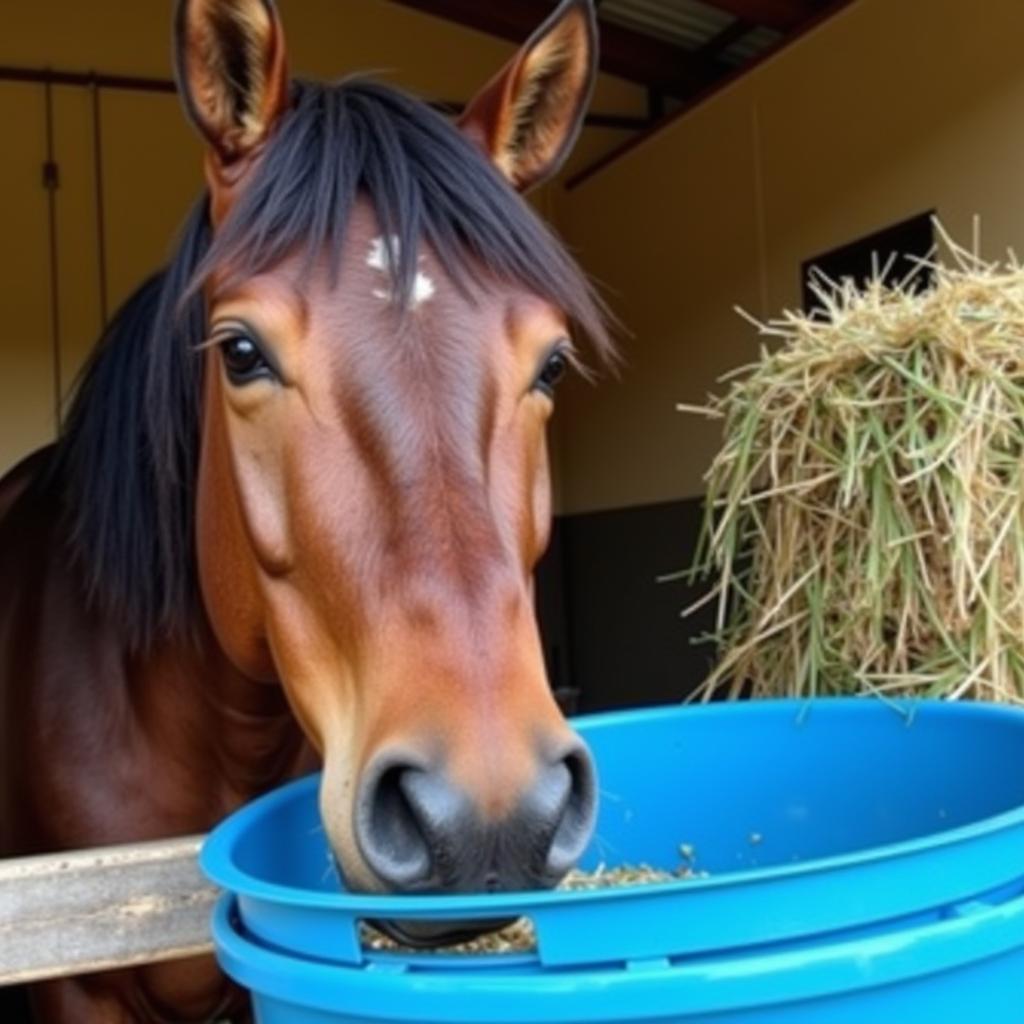Feed Buckets For Horses are an essential part of equine management. Choosing the correct bucket can impact a horse’s health, comfort, and even their behavior. From size and material to design features, understanding your options will ensure your horse’s feeding experience is optimized.
 Horse Enjoying Meal from a Feed Bucket
Horse Enjoying Meal from a Feed Bucket
Different Types of Feed Buckets for Horses
There’s a surprising variety of feed buckets for horses available on the market. Each type caters to specific needs and preferences. Let’s explore some of the most common options.
Rubber Feed Buckets: Durable and Safe
Rubber feed buckets are a popular choice due to their durability and safety. They can withstand the wear and tear of daily use, including being tossed around by a playful or frustrated horse. Rubber is also less likely to chip or break, reducing the risk of injury.
Plastic Feed Buckets: Lightweight and Affordable
Plastic feed buckets are a lightweight and affordable option. They come in various sizes and colors, making them a versatile choice for different feeding needs. However, they are less durable than rubber and can crack or break if mishandled. If you’re looking for feed buckets for horses that choke, consider a slow feed option.
Metal Feed Buckets: Classic and Long-lasting
Metal feed buckets, typically made of galvanized steel, offer exceptional durability. They are resistant to rust and can withstand even the most enthusiastic equine diners. While they are a classic and long-lasting choice, they can be heavier than other options.
Slow Feed Buckets: Promoting Healthy Digestion
Slow feed buckets are designed to encourage slower eating habits, promoting healthy digestion and preventing issues like choking and colic. These buckets often have internal grids or obstacles that force horses to take smaller bites. This can also help reduce boredom and extend feeding time. You can learn more about essential horse supplies on our things you need for horses page.
What Size Feed Bucket is Right for My Horse?
The size of your horse’s feed bucket will depend on the amount and type of feed you provide. A standard size is around 12 quarts, but smaller or larger buckets might be more appropriate depending on individual needs. For example, a pony might require a smaller bucket, while a large draft horse might need a larger one.
“Choosing the correct bucket size is crucial,” explains Dr. Emily Carter, DVM. “Overfilling a small bucket can lead to spillage and wasted feed, while underfilling a large bucket might not provide enough for a horse’s nutritional needs.”
Choosing the Best Material for Your Horse’s Feed Bucket
Each material has its pros and cons. Consider factors like durability, ease of cleaning, and safety when making your decision.
- Rubber: Durable, safe, but can be heavier.
- Plastic: Lightweight, affordable, but less durable.
- Metal: Long-lasting, resistant to rust, but can be noisy.
“I often recommend rubber buckets for their durability and safety,” advises Sarah Miller, Equine Nutritionist. “While they may be more expensive initially, their longevity makes them a worthwhile investment.”
Tips for Cleaning and Maintaining Feed Buckets for Horses
Regular cleaning is essential to prevent the growth of bacteria and mold. Scrub buckets thoroughly with soap and water, and allow them to dry completely before refilling.
What if my horse is going camping?
When planning a trip with your equine companion, be sure to include a durable and easy-to-clean feed bucket in your packing list. You can find tips for traveling with your horse on our camping and horses page. You may also be interested in our play stable for horses page for more ideas for enriching your horse’s environment.
Feed Buckets for Horses: Conclusion
Choosing the right feed buckets for horses is an important aspect of horse care. By considering factors like size, material, and design, you can ensure your horse’s feeding experience is safe, comfortable, and promotes optimal health. For those with specific dietary needs, consider hospital plates for horses for controlled feeding. Remember, the right feed bucket contributes to a happy and healthy horse.
FAQ
- How often should I clean my horse’s feed bucket?
- What size feed bucket is appropriate for a miniature horse?
- Can I use a dog bowl as a feed bucket for my horse?
- Are slow feed buckets suitable for all horses?
- What should I do if my horse’s feed bucket is cracked or broken?
- How can I prevent my horse from tipping over their feed bucket?
- What are the signs of a horse choking on their feed?
Common Scenarios and Questions
-
Scenario: My horse keeps tipping over his feed bucket.
-
Question: How can I prevent this? Consider weighted buckets or secure attachments.
-
Scenario: My horse is a messy eater.
-
Question: How can I minimize feed spillage? Opt for a deep, wide-bottomed bucket.
-
Scenario: My horse eats too quickly.
-
Question: How can I slow down his eating? A slow feed bucket is a great solution.
Further Resources
For additional information on horse care and equipment, visit our website. You might be interested in articles on horse grooming, stable management, or choosing the right tack.
For assistance, contact us 24/7:
Phone: 0772127271
Email: [email protected]
Address: QGM2+WX2, Vị Trung, Vị Thuỷ, Hậu Giang, Việt Nam.